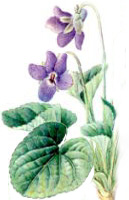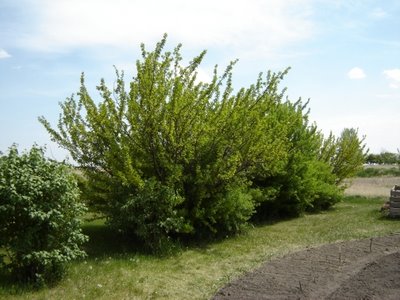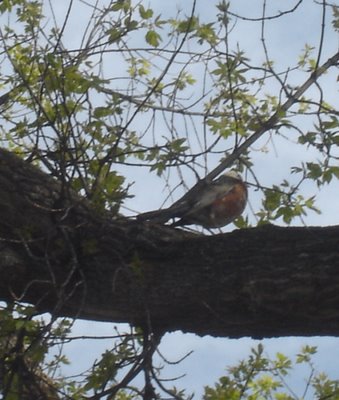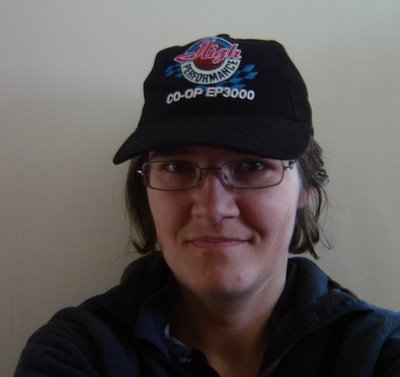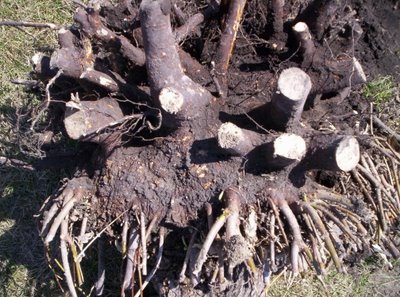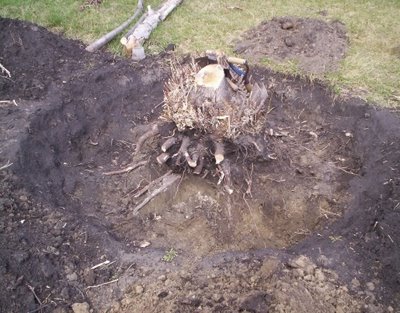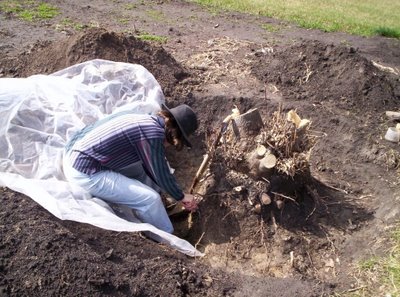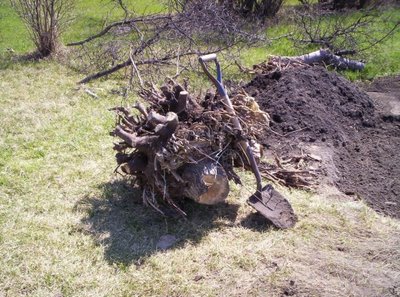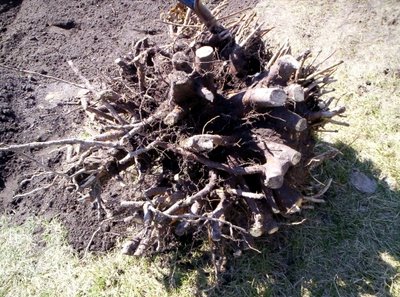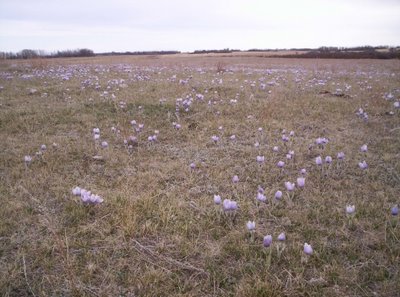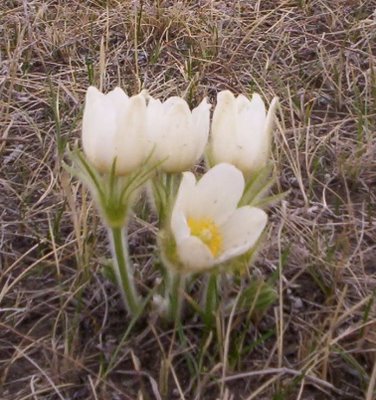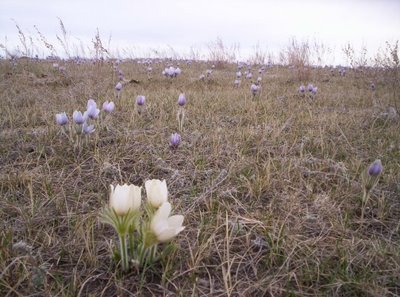Laura Herman
St. Andrew’s United Church, Arcola, SK
April 2nd, 2006
Two weeks ago, I came home from the singing workshop at PCTC-Calling Lakes Centre with a song running in my head, in my heart, and in the rhythm of my steps along the street. I walked down Souris Avenue and up Carlyle Street to this church, and that song swung along with me. Perhaps it’s running in your head right now.
[The song was “Oh Great Earth" by Linnea Good.]
As I walked, I was thinking about wisdom. I was wondering what simple sayings could be written to guide someone who wants to live God’s love in this world.
The rhythm of my footsteps took me along under the arching trees, past their sturdy trunks, one after another, and all at once I was thinking about wisdom that is already written in those trees.
It started with the roots.
Trees stay in one place. They reach deep into the soil and draw out what is stored there from all that has gone before. They draw up water that sank into the earth months or years ago. They draw up nutrients that have been laid down over decades and centuries and more. They cannot wander in search of a better place, but they make their own place better.
A lecturer once said: “If you want to change the world, pick a place and stay there.” Another teacher said, “Do with what you have at hand.” Still others have taught that although you may see great good in other religions, it is best to go deeply into your own religious tradition, for you will find what you are seeking there. And in Tai Chi, we learn the principle of returning to your root. When we practise Tai Chi, we move through a sequence of postures taking us away from our starting point and back again, so that we end where we began.
I see wisdom in all these teachings about rootedness, because I have been a wanderer, always seeking that greater wisdom that would help me save the planet. There are many wanderers in our modern world, always seeking ways to better the world or themselves. Some accomplish great things, but as I wandered and listened to the stories of other wanderers, I got the sense that even greater good would come, if many of us went home and tended to our own little pieces of the Earth.
A tree does not wander in search of good that it may do elsewhere. There are other trees in the forest for that. When the troubles of the world seem overwhelming, we can remember that others see and care about those same troubles, and all over the world, they are doing what they can in their own places.
Trees grow slowly. Grass springs green in just a few days, but it takes years for the boughs of a tree to spread and give shade. As the hero of a Nicholas Sparks novel said, “I often overestimate what I can do in a day, but I underestimate what I can do in a year.” Little by little, if we are patient, letting the Spirit work through us, we may be amazed to see what grows from small beginnings.
Not only do trees stay still; they also keep within themselves traces of all that has gone before. In the rings of their wood, they keep a record of the past. Although the growing part of the trunk is a thin layer near the surface, all the older wood within gives strength and support to the whole tree. It is easy to give all our attention to the growing edges of things, but it is important to honour the past as well. Much of the everyday goodness of our lives is the result of struggles in the past, when such goodness was not so ordinary.
The tough bark of a tree is old as well, thickened and hardened in response to all the little stresses and injuries of weather and wild things. A certain amount of toughness is a good thing, so that we don’t waste our energy on woundedness; we just let the blind, random bumps of the world bounce off us without harm.
In spite of the hardness of their wood and the toughness of their bark, trees can bend and sway in the wind. If they lose that flexibility, they may snap in a storm, and all those years of slow and steady growth are lost in a moment. But as long as they can bend, the branches can give a little when pressures are extreme, and still spring back to their true form when calm returns.
A tree can endure for many decades or even centuries, and even send up new shoots from the stump of an ancient trunk. Still, no tree will last forever. A fire may sweep through the forest, or waters may rise, or deserts spread. No matter how ancient the tree, it takes only a moment to topple. Yet even as the wood rots away, younger trees are reaching upward, unfolding the essence of that same tree that bore the seeds from which they grew.
If we share the wisdom of our experience with others, it is not lost to this world when we pass on. We might think we have nothing of value to share, but it doesn’t have to be something that will change the whole world. It could be something that will help carry on the simple goodness of this piece of the Earth, some piece of wisdom of this place, something that a wise person from another place would not understand. And if we take the time, not only to grow our own skills, but to tend and nurture those skills in others, we make our way of life as enduring as a forest.
Trees give. Not only do they give life to a new generation of seedlings; trees also offer gifts to people and many other living things. They give shade, shelter from wind, fruit in its season, and beauty for those who pause to see it. They give without being asked or thanked, and without even knowing whether anyone will be there to receive what they offer. These gifts simply flow from the very nature of trees, from the way God has created them.
Sometimes our giving can feel awkward, or contrived, if it comes more from outside expectations than from our own nature. Still the Spirit works within us, unfolding the gifts that God is creating and nurturing in us. Our work is to attend to that growth, to trust it and support it, and through it, to explore new ways to reach upward to the light of Christ in our world.
This brings me to the lesson of the trees that overwhelmed me when I saw it.
Although I have spoken about firm roots, strong wood, and tough bark, trees also have tender buds and delicate leaves. They drop their leaves and toughen their twigs in preparation for winter, but in spring the buds soften and swell, and fragile films of green emerge into the sun.
There is no way that a tree can take the sun and grow new branches reaching higher to the sky, unless it first grows those tender, vulnerable buds and leaves.
In these days of spring, the twigs are softening; the buds are swelling.
In these days of Lent, God calls us to soften our hearts, to risk new growth that reaches beyond the sturdy teachings of our tradition — reaches into the light of a direct relationship with God.
